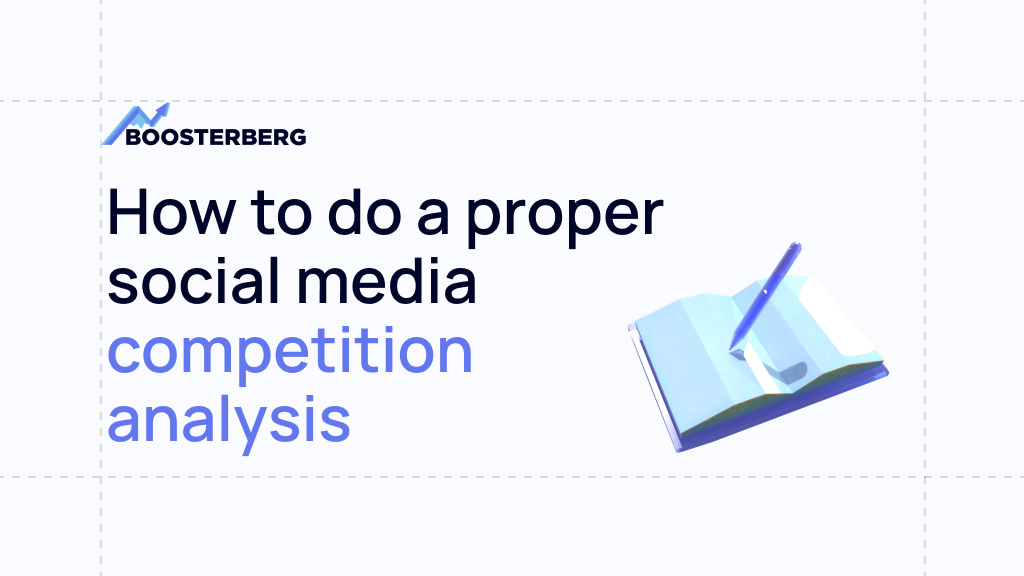What is important for the start of any business? We can certainly agree that the right decisions are essential. How many times in various interviews with successful entrepreneurs we hear, “I made the right decision that time”. But at the same time, we often hear in interviews sentences like, “If I had known better then, I would not have made the same mistake”. So what can one “know better”? In this sense, there are two most important analyses and that is competitor analysis and market analysis. With that being said, welcome to the second part of our how-to for the competitor analysis (link for the 1st part here).
How often should you do it?
For numerous businesses, the sweet zone is a quarterly (or even monthly) analysis. Everything depends on the rhythm of your industry and the pace of your company. Whatever tempo you find useful for your specific situation.
How to make a competitive analysis on social media in 4 steps
To make the process of making the social media competition analysis process easy, we have broken it down into 4 easy steps that will work for any business.
STEP 1: Find out who is your competitor
It’s impossible to analyze your competitors on social media without knowing who they are and which social platforms they use. So here’s how to find them:
Find your competitive keywords
Even before you start researching your competitors, you probably have an idea of the keywords you want your customers to search for in order to get to your business.
For instance, if you work in the running shoes industry in Pasadena, you’ll likely want to rank for keywords like “running shoes in Pasadena” and “Pasadena clothing stores”. Or if your store sells affordable clothing, then you can be certain that stores like Louis Vuitton or Gucci are most probably not your direct competitors.
Knowing the most important keywords for your brand will help you identify who your competitors are and which ones are worth targeting. This is why it’s important to start using tools such as Google Ads Keyword Planner. This tool is free, and chances are, you are already familiar with this tool. Keyword Planner can analyse your website and give you a list of relevant keywords with their average search volume and competition level as a bonus.
For example, here is the way to find out new keywords that Keyword Planner would suggest for the whole site of our competitor:
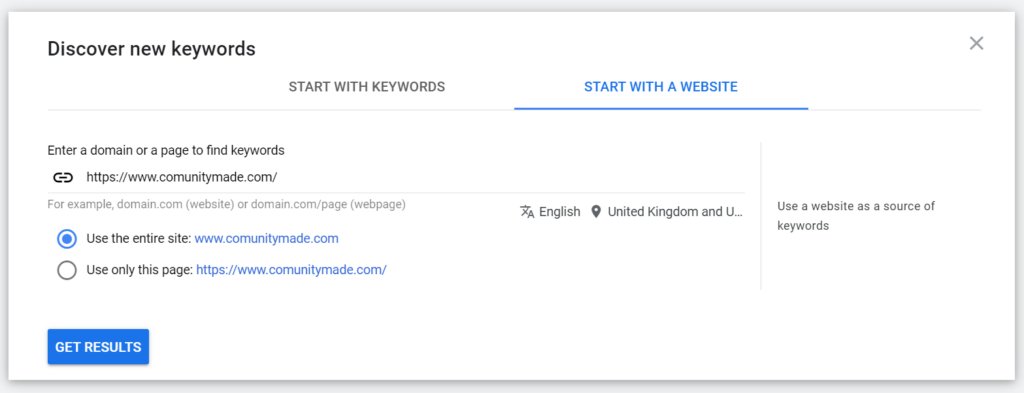
For this example let’s say we are a smaller business and our competitor is a handcrafted shoemaker from California.
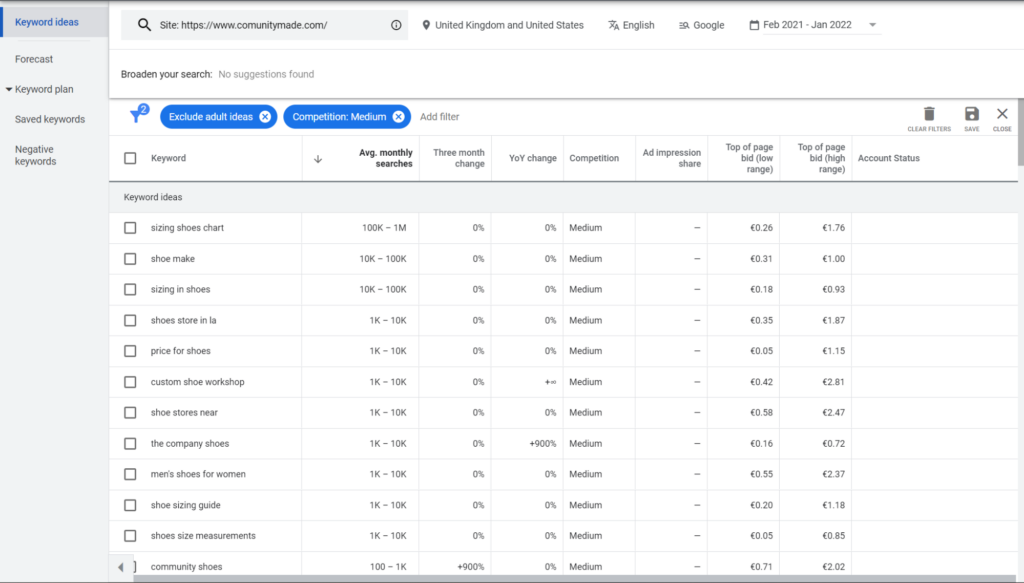
If you already know your target keywords, just enter them into the tool to get related keywords. You can use these related keywords to narrow your list of potential competitors, allowing you to analyze companies that are frankly competing with yours. A little tip from us is to sort the keywords by average monthly search, exclude adult ideas (if applicable for your business) and let’s save some money by looking only for Medium competition keywords.
Then you can do a simple Google or Social media check and see who’s ranking for those keywords in the results. Choose 5 to 10 keywords that you think are most relevant to your business and write them down (either on paper or even better create a spreadsheet). Look through the results pages (SERPs) to figure out the businesses that rank high for your keywords. Don’t forget to note businesses that pay for Google Ads to appear at the top of the organic search results, because they are investing money to achieve their marketing goals. Even if these businesses don’t rank high on SERPs yet, you should double-check their performance on social media.
Visit the websites of the businesses that look like potential competitors. Most business websites put links to their social media footer of their page. For example, our has it like this:
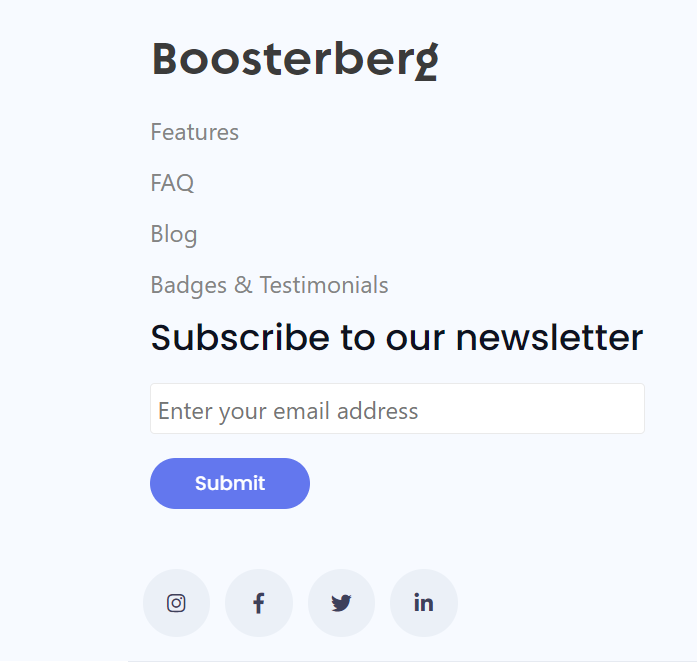
Cope these links somewhere aside for your competitive analysis. The best way is to create that spreadsheet. Check who appears in social searches for your top keywords.
Just because certain brands rank high for your keywords on search engines doesn’t mean that they rank well for those same keywords on social media. Since you’re conducting a social media competition analysis, you want to focus on competitors that rank the best in the social search results.
For instance, to find competitors on Facebook, enter your keyword into the search box and click on Pages in the left column.
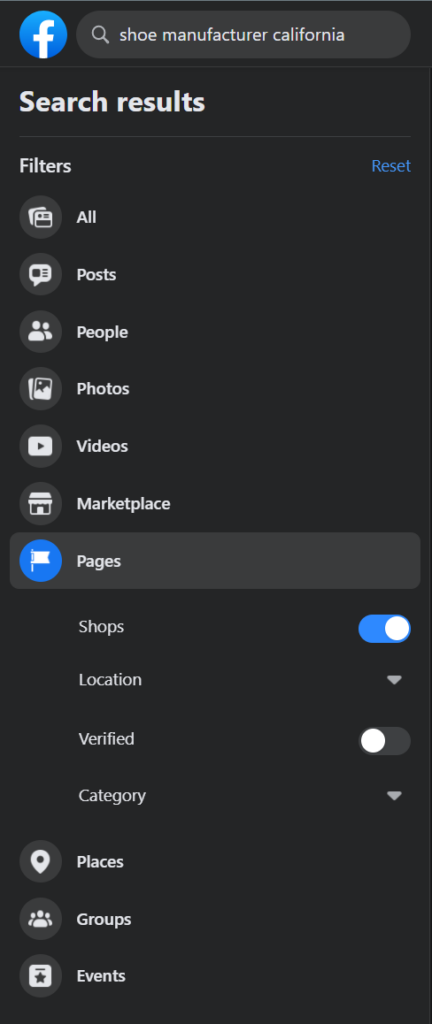
Find out what brands similar to yours your audience likes. At this point, you probably have a long list of potential competitors – way more than you can analyse in detail. So trim your list down to let’s say the top five brands you most closely compete with on social media.
STEP 2: Harvest the data
By studying the various social media platforms of your competitors, you will be able to identify which ones are performing well. Remember those social media links you got from the brands’ websites? Visit those profiles and note down the following in your social media competition analysis spreadsheet.
– What social media platforms are your competitors on?
– How many fans do they have, and what’s their content strategy?
– How often do they share content and what is their engagement like (+what are the top-performing posts)?
– In what tone do they speak to their fans? Is it casual, conversational, or formal?
– For what purpose are they publishing? Is it to entertain, educate, promote, or do something else?
Look up all of these things on your own channels too. This will help you with the analysis in Step 3.
STEP 3: Run a strategic analysis like SWOT
After collecting all the insights you find useful for your business, the next step is to evaluate it and understand how your business stacks up compared to your competitors. As a result of this evaluation, you should note the following:
S – Strengths
W – Weaknesses
O – Opportunities
T – Threats
Your strengths and weaknesses are internal factors. To find these, you have to look at your business and identify where you excel and where you fall short.
Strengths describe what your brand does very well – or better than most of your competitors. To identify your strengths, check these things:
– Are your posts in your brand voice?
– Is your branding consistent across all of your social channels?
– Do you have a community engaged on social media?
– Does your graphics reflect your brand colours?
– Do you have more followers than your competitors?, etc…
The next step is to identify the Weaknesses preventing your business from reaching its full potential on social media. So, to find out where your business is falling behind competitors and in order to make the changes to your social media strategy to improve in these areas you need to identify them. Look at areas where your business is lagging behind. These are the aspects you want to improve.
Ask (and answer) questions like:
– Are you posting regularly? Do you keep it so your customers can happily wait for the next article?
– Are you ignoring any important platforms that your target audience uses? Are they on Facebook, Twitter, or do they just use Instagram? What if they use LinkedIn too? or something else? Are you ignoring any important platform? Or are you using platforms that don’t benefit your business?
– What metrics could you improve upon?
– Which social platforms do your competitors do better than you on? How do they do it?
Consider your strengths and weaknesses for each social platform when answering these questions. For example, you may have a higher Instagram follower count than your competitors, but they may have a higher engagement rate. That’s why it’s important to be specific.
Now that you know where you fall short compared to your competitors, start looking for opportunities and threats you can leverage in order to succeed. Opportunities and threats are external factors, you have to critically assess your competitors to find areas for improvement in your strategy and pinpoint any potential problems.
You can identify Opportunities based on the data you’ve collected, or you can identify them due to changes in the online world. For instance, TikTok is growing quickly, and many brands and creators are jumping on the opportunity to implement this new platform into their social strategies. Here are a few things you should look for:
– If your competitors haven’t used the newest social media features or platforms yet, you may be able to be the first.
– Have you gained traction exclusively through organic social media? If you haven’t run social media ads, try testing a campaign to improve your performance, or introduce a smart boosting by Boosterberg to your strategy
– Consider adding Instagram Reels or YouTube Shorts to your content mix to test if your audience engages better with short videos rather than long ones (or vice-versa).
In order to identify social Threats to your business, look at what could negatively impact your social performance over time. Here are a few potential threats examples:
– A lot of negative customer reviews of your brand
– Competitors who are newly established to your niche and growing fast
– Industry changes like Apple’s iOS14 or simply social media trends shifts that may affect your business’ visibility
You might already notice some threats. For example, a competitor that has few posts on Instagram but has a high engagement rate is a bigger threat than one with many posts but low engagement. That is why you need to keep a close watch on the industry for changes that can help your competitors to outshine your brand.
STEP 4: Keeping your social media competitive analysis up to date
Keeping your social media competitive analysis current requires you to add new information about the market and any new competition frequently. You should do this during your quarterly or (if relevant) annual reports to keep it current.
By creating an effective social media monitoring strategy you will be able to get real-time information to integrate in your next marketing strategy.
Do You Need Some Inspiration?
Take a look at our previous post like The End Of Facebook In The EU? Don’t Get Fooled or check out our case studies from marketing professionals like The Most Common Mistakes In Facebook Advertising: The Structure in the meantime.
